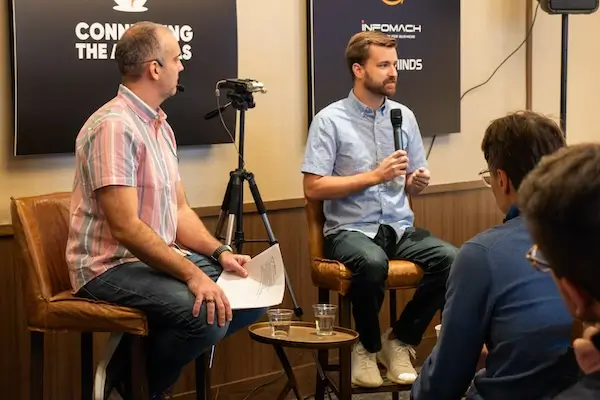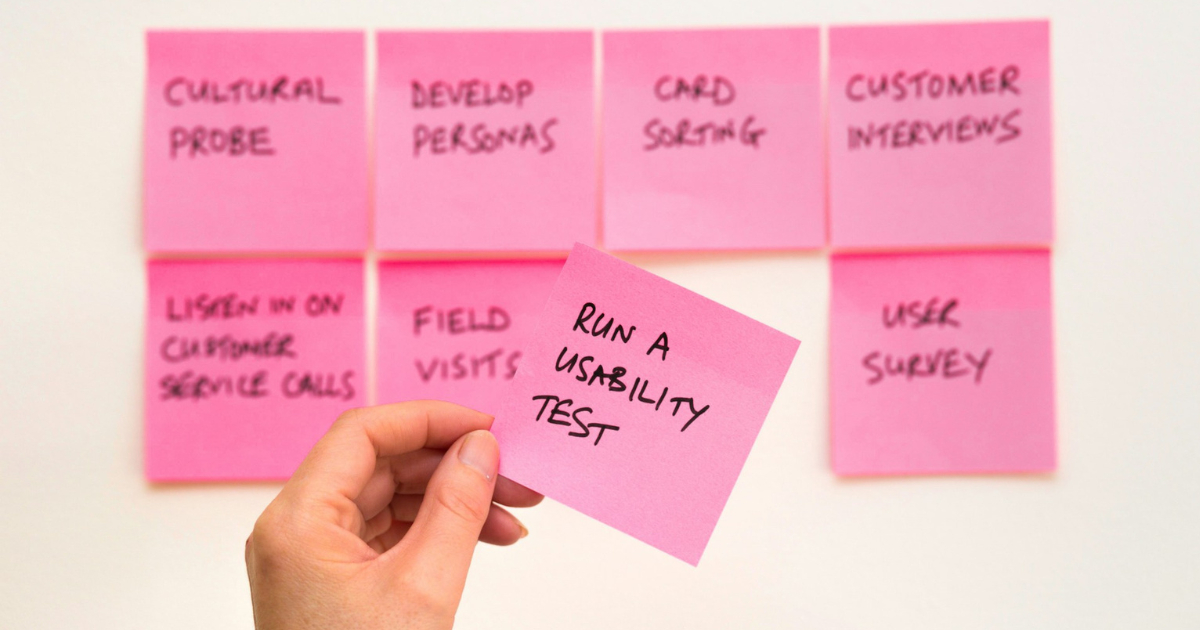What are the intricacies of designing user experiences for millions of users? From navigating the challenges of small-scale startups to the complexities of billion-user platforms, join us in exploring how the intersection of design, product, and innovation leads to impactful design.
We curated Austin Knight (Design Lead at Square and advisor at Sequoia Capital)’s key insights during Connecting the Americas‘ side event at SXSW 2024.
Here are the highlights of his fireside chat with Alberto Silveira, one of the event’s co-creators:
[ez-toc]Curious for an in-depth learning experience? Here’s the full video of their exchange:
Not able to view the full event? Take a quick glance at this overview article. Enjoy!
5 Lessons From the Past: Why “Form Over Function” Design is Outdated
Learning from the experiences of those who have come before us spares us a lot of legwork and stress. Before we start on UX best practices, it’s worth it to glean overall lessons from Austin Austin’s career. He uncovers essential lessons that can shape our own approach to design and problem-solving:
Lesson 1: Embrace Setbacks as Opportunities
We’ve all faced setbacks in our creative endeavors —and they’re an opportunity for growth. Whether it’s a failed project or an idea that didn’t quite take off, there’s always something to learn from the experience.
Lesson 2: Iterate, Iterate, Iterate
Design is rarely a linear process. It’s about constant refinement. Recognize that initial concepts may need tweaking or even complete reimagining to reach their full potential.
Lesson 3: Put Users First
At the heart of great design lies a deep understanding of user needs. Prioritizing user feedback reminds us that design isn’t just about creating something beautiful—it’s about solving problems and meeting the needs of those who will use our products or services.
Lesson 4: Stay Resilient in the Face of Challenges
The design world is full of challenges and uncertainties. The ability to persevere through tough times and pivot when necessary serves as a reminder of the importance of resilience and adaptability in our own creative pursuits.
Lesson 5: Value Diverse Experiences
Our journey as designers is shaped by the diverse experiences we encounter along the way. Whether it’s a successful project or a failed experiment, each experience contributes to our growth and development as creatives.
It’s crucial to value the diverse experiences that shape designers’ journeys; it helps whole teams navigate the complexities of software-building with confidence and purpose.
Translating This Designer Mindset into Impactful Software
Do the lessons thus far resonate with you? Then you should be aware the mindset of designers plays a crucial role in shaping impactful software that resonates with users on a global scale.
Once again, Austin borrows from experience to shed light on how this translates into tangible results within the realm of UX design. Here’s a compilation of best quotes:
Iterative Experimentation
With billions of users at stake, every feature rollout becomes a meticulously planned experiment. This approach allows designers to fine-tune details and optimize user experiences over time, ensuring that each iteration brings improvements that resonate with the diverse needs of the user base
“When you’re working at scale, a lot of it is just like, really, really tweaking the fine details. And that takes a lot of patience.” — says Austin.
Designing for billions of users requires a deep understanding of user needs and preferences. Austin’s involvement in redesigning Google’s feeds and leading the design of COVID-19 contact tracing platforms underscores the significance of prioritizing user-centric design principles.
“Everything is an experiment… You’re really, really cautious because, you know, a drop in certain metrics, that could just be a fraction of a percent, your feature is gonna get killed.” — he explains.
By placing users at the forefront of the design process, designers can create software solutions that address real-world challenges and make a meaningful impact on people’s lives.

Austin Knight, Speaker on UX for Billions at Connecting the Americas (Photo by: Riff Filmes)
Collaboration and Adaptability to Data Findings
Austin was one of four designers that were responsible for Google and Apple’s COVID-19 contact tracing platform, which was adopted by over 40 public health authorities around the world. There, he learned effective collaboration enables designers to leverage diverse perspectives and resources to achieve common goals.
“We were working really fast working across platforms and companies actually, it was a really unique partnership that was fun”, he recalls. To him, adaptability allows designers to navigate fast-paced environments and respond swiftly to evolving challenges and opportunities.
But when deciding on which way to go, it’s not enough to have experience and broad range of references. Austin’s emphasis on tracking metrics and analyzing user feedback underscores the importance of data-driven design approaches.
He suggests that while design often involves subjectivity, it benefits from adopting a more objective perspective:
“Design is not art. And good design is humble.”
Austin’s viewpoint underscores the need for design to be grounded in humility, acknowledging its impact while continuously striving for improvement and alignment with broader business objectives.
By harnessing data insights, designers can identify areas for improvement, validate design decisions, and drive continuous optimization to enhance the overall user experience.
Building High-Performance Design Teams to Raise Design Standards
success is often a team effort. The collaborative synergy between engineers, designers, product managers, and leadership is what drives innovation and delivers impactful solutions to users. But how does one go about assembling such a team, especially when aiming to cater to billions of users?
According to Austin Knight, the process of building a high-performance design team starts with recognizing a key paradox: “Good designers hire good designers”, he states.
Starting Out: Seek Guidance From Experienced Design Leaders
“Try to identify a design leader that is in their industry or somebody that maybe has done what they’re wanting to do with their company.”
In the early stages, when resources might be limited and making the first design hire seems daunting, seeking guidance from experienced design leaders can be invaluable. These seasoned professionals can offer insights into identifying the right talent and may even help tap into their network to find suitable candidates.
Attracting Talent: Prioritize Design Excellence Early On
Knight emphasizes the importance of design excellence as an initial signal to potential hires:
“If I’m thinking about joining a startup, and I see oh, it’s only like two or three people, four people, and they’re all co-founders, but they’ve got a really, really nice design, that would actually be a really positive signal for me.”
He suggests that startups prioritize design within their first few hires, ideally within the first five, to establish a solid foundation for their product. A well-crafted design not only enhances the user experience but also serves as a testament to the company’s commitment to quality and innovation, thereby attracting top-tier talent in other areas too.
In essence, the kind of people who thrive under this mindset are those who value and prioritize design excellence, collaboration, and innovation. They are individuals who understand the pivotal role of design in shaping user experiences and are driven to create solutions that resonate with billions of users worldwide.
By assembling such a team, software businesses can leverage diverse talents and perspectives to drive success in an increasingly competitive market landscape.

Impactful Design Fireside Chat during SXSW side event (Photo by: Riff Filmes)
The Iron Triangle: Product, Design, and Engineering Stand Shoulder-to-Shoulder
Alberto concurs wholeheartedly that from the outset of a company’s journey, design should stand shoulder to shoulder with product and engineering, rather than be subordinated to them. He emphasizes the importance of this alignment early on, stating, “It’s not a matter of if you need to bring design, it’s a matter of when.”
This sentiment underscores the essence of the Iron Triangle approach.The Iron Triangle is a framework that advocates for the tight integration (and balanced tension) of Product, Design, and Engineering within a company’s organizational structure.
This model ensures that these three essential functions collaborate closely throughout the product development lifecycle, enabling efficient communication, synergy, and alignment of goals.The Need for Power Balance Within Software Teams
Austin staunchly defends the need to respect design knowledge and expertise within this framework. “Design has to be accountable to design standards.”, he argues. Holding it to Product or Engineering priorities may actually keep companies from user-centric approaches… after all, these other disciplines have market and operational needs at heart.
However, he reminds us there is still a long way to go. Traditional software companies still don’t fully recognize design’s unique contribution to the end result. “It’s hard to quantify the impact of design without strong design leadership that can articulate that to the rest of the business”.
Establishing a functional structure for design leadership is crucial. This structure typically includes positions such as a VP of design, Chief Design Officer, or Head of Design… a person who directly reports to the CEO. This organizational setup contrasts with having design report to a VP of Engineering or Product, a common practice in many companies.
Notably, companies like Apple and Square already follow this balanced, functional model. “Moreover, aligning the entire company under a single profit and loss (P&L) model fosters cohesive incentives across the organization”, he suggests.
More on Design-Centric Organizations
While not every company identifies as “design-driven,” integrating design principles into core functions is increasingly vital for sustained success. Here are key traits and examples:
- Centralized Collaboration: Design-centric companies can be creative in their collaboration platforms. Square uses Figma instead of GSuite, for instance. Jack (Dorsey, Twitter co-founder) presents from Fitbit. “I didn’t believe it until I saw it”, Austin jokes.
- Strategic Investment: By embedding design thinking early on, they mitigate disruption risks and foster innovation. Investing in design from the outset reduces the need for costly adjustments and cultivates adaptability.
In essence, design-centric organizations prioritize design as a core component, leveraging it strategically for innovation, user experience enhancement, and sustained competitiveness. Neglecting design can lead to missed opportunities and blind spots, even if some companies may temporarily succeed due to regulatory advantages or market positions.
4 Tips on Balancing Good Design with Business and Market Context
As companies evolve and grow, it’s essential to reflect on past practices and recognize the relative insignificance of certain risks in the grand scheme of growth. By prioritizing learning and adaptability, teams can focus on what truly matters for sustainable success.
#1 Avoid Over-Indexing on Perfection. There is often a temptation to place undue emphasis on achieving perfection, particularly when operating at scale. Instead, strike a balance between striving for quality and acknowledging the necessity for swift iterations.
#2 Strive for a Healthy Balance of Process. Introducing excessive process and constraints can hinder the agility and creativity of design teams. Allow design teams to take on principled risks.
#3 Be Strategic about Decision-Making. A successful design organization is grounded in a deep understanding of the product and its performance.
- Designers equipped with data literacy skills are able to effectively integrate business insights into their decision-making processes.
- Strategic investments in innovative concepts with swift releases for feedback allows design teams to iterate rapidly while staying in line with overarching product goals.
#4 Don’t Overthink Scale. It’s important for design teams, especially in smaller to medium-sized companies, to resist the urge to overdo processes.
- While legal and compliance considerations are paramount, overly rigid processes can stifle creativity and hinder innovation.
- Getting the product out and learning from user interactions is more significant than reaching a perfect version of it.
Otherwise, what happens? When questions about “We were obsessing over the small things that in the grand scheme of things were completely inconsequential.”
Organizational Influence on Impactful Design Culture
In software companies, the organizational structure and culture significantly shape how design is integrated into product development. Here’s how
Factors to Consider
- Design approaches may vary by industry, but core human factors remain consistent. However, day-to-day practices and communication strategies differ based on industry demands. For instance, consumer app design requires more direct user interaction compared to enterprise applications.
- Company size also influences design strategies. Smaller companies often boast agility and innovation due to their nimbleness, while larger enterprises face challenges in swift maneuvering. Small organizations can innovate more authentically without the constraints of large-scale operations.
The Pitfalls of Copying and the Value of Innovation
- Many smaller companies fall into the trap of copying strategies from larger competitors. However, this often leads to outdated practices and missed opportunities for true innovation.
- While certain interaction patterns are worth emulating, blindly copying strategies from industry giants can result in lagging behind, as innovations take time to permeate from conception to execution.
Fostering Design Culture
- Design-driven organizations prioritize design as a strategic asset and embed it into their core functions. A strong design leader plays a pivotal role in shaping the design culture, attracting diverse talent, and fostering a collaborative environment.
- Design culture evolves organically within a company, influenced by its leadership, hiring practices, and values. Even companies that prioritize other aspects over culture inevitably develop one, making it crucial to cultivate a culture aligned with the company’s goals and values.
In essence, the organizational structure and culture of a software company profoundly influence how design is perceived, integrated, and leveraged to drive innovation and success.
Ready to Keep Learning From Industry Experts?
Excited to delve deeper into the realm of impactful UX design? If you found this conversation insightful and are hungry for more, we’ve got you covered! Explore additional summaries from the Connecting the Americas fireside chats here and here.
And don’t forget to stay in the loop for upcoming Connecting the Americas events by signing up below. We’ll make sure you’re first to know about future sessions and stay informed on all things UX!
Further Context

International Marketing Leader, specialized in tech. Proud to have built marketing and business generation structures for some of the fastest-growing SaaS companies on both sides of the Atlantic (UK, DACH, Iberia, LatAm, and NorthAm). Big fan of motherhood, world music, marketing, and backpacking. A little bit nerdy too!


